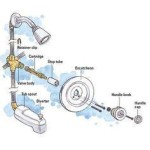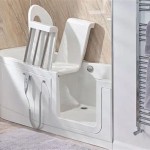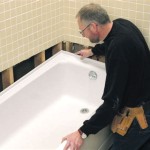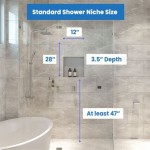Bathtub Design: Integrating Clawfoot Aesthetics into Wall-Mounted Fixtures
The bathtub has evolved significantly throughout history, transitioning from rudimentary water receptacles to elaborate statement pieces. One recurring element in bathtub design that evokes a sense of both luxury and historical significance is the incorporation of clawfoot legs. Traditionally, these legs are integral to the bathtub’s structure, providing support and elevating the tub from the floor. However, contemporary design explorations have sought to integrate the aesthetic appeal of clawfoot legs into wall-mounted bathtubs, presenting a unique fusion of classic and modern sensibilities.
The impetus behind this trend stems from a desire to retain the visual charm of traditional clawfoot tubs while capitalizing on the practical advantages offered by wall-mounted fixtures. Wall-mounted bathtubs, unlike their freestanding counterparts, often facilitate ease of cleaning beneath the tub and can contribute to a more minimalist and spacious bathroom design. The challenge lies in replicating the visual weight and elegance of clawfoot legs in a manner that complements the clean lines of a wall-mounted structure.
Several approaches have been adopted to achieve this integration, ranging from purely decorative applications to structural adaptations that subtly allude to the traditional clawfoot design. This article will explore the various methods employed in incorporating lion feet and legs into wall-mounted bathtub designs, examining the aesthetic considerations, engineering challenges, and ultimately, the potential impact on bathroom aesthetics.
Aesthetic Considerations in Replicating Clawfoot Elegance
The primary objective when incorporating clawfoot aesthetics into wall-mounted bathtubs is to maintain the elegance and visual appeal associated with traditional clawfoot designs. This requires careful consideration of several factors, including the style of the clawfoot legs, their placement relative to the tub, and the overall material palette of the bathroom.
The style of the clawfoot leg itself is paramount. Lion feet are a particularly popular choice, representing a bold and regal design element. These feet often feature intricate detailing, showcasing stylized depictions of lion paws, claws, and even facial features. Other styles, such as ball-and-claw feet or eagle claw feet, offer alternative aesthetic nuances, each contributing a unique character to the overall design. The choice of style should align with the overall design scheme of the bathroom, whether that be Victorian, Art Deco, or a more contemporary interpretation.
Placement of the legs is another crucial aesthetic consideration. In traditional clawfoot bathtubs, the legs provide primary support and are typically positioned at the four corners of the tub. When adapting this to a wall-mounted design, the legs can be implemented in several ways. One option is to attach decorative legs directly to the wall beneath the bathtub, mimicking the appearance of a supported tub. Another approach involves integrating the legs into the bathtub's skirt or apron, creating a visual illusion of support while the actual support is derived from the wall mounting system. In either case, the positioning and spacing of the legs must be carefully considered to ensure a balanced and visually pleasing composition.
The material palette plays a significant role in the overall aesthetic impact. Clawfoot legs are traditionally crafted from cast iron or brass, often finished in polished chrome, brushed nickel, or painted to match the bathtub's exterior. When integrating these legs into a wall-mounted design, it's essential to maintain consistency in materials and finishes to create a cohesive look. Using contrasting materials, such as pairing a sleek, modern tub with ornate, antique-finished lion feet, can create a striking statement, but requires careful planning to avoid clashing aesthetics.
Engineering Challenges in Wall-Mounted Clawfoot Designs
Integrating the aesthetic of clawfoot legs into wall-mounted bathtubs presents several engineering challenges. The primary concern is ensuring the structural integrity and safety of the installation while effectively mimicking the visual support provided by traditional clawfoot legs. This requires a careful balance between decorative elements and functional support systems.
The weight distribution of a filled bathtub is a significant factor. Traditional clawfoot tubs rely on the legs to distribute the weight evenly across the floor. In a wall-mounted design, the wall itself must bear the entire weight of the tub, water, and occupant. This necessitates a robust wall mounting system, often involving reinforced brackets and anchoring bolts that are embedded deep within the wall studs or concrete. The wall's structural capacity must be carefully assessed to ensure it can safely support the load.
The method of attaching the decorative clawfoot legs to the wall or bathtub skirt presents another challenge. These legs must be securely fastened to prevent them from detaching or becoming unstable. Depending on the material composition of the legs and the bathtub, various fastening techniques can be employed, including welding, bolting, or adhesive bonding. In cases where the legs are purely decorative and do not contribute to the structural support, it is crucial to ensure they are securely attached to prevent accidental dislodgement.
Furthermore, plumbing considerations must be addressed. In traditional clawfoot tubs, the exposed plumbing adds to the vintage aesthetic. When adapting this to a wall-mounted design, it may be desirable to replicate this look by exposing the plumbing fixtures. However, this requires careful planning to ensure the plumbing is aesthetically pleasing and easily accessible for maintenance. Alternatively, the plumbing can be concealed within the wall, creating a cleaner and more modern appearance.
Finally, accessibility and clearance must be considered. Wall-mounted bathtubs are often chosen to facilitate easier cleaning beneath the tub. However, the presence of decorative clawfoot legs, even if they are attached to the wall or skirt, can potentially impede access and make cleaning more difficult. Therefore, the placement and design of the legs must be carefully considered to minimize any obstruction and maintain the practicality of the wall-mounted design.
Implementation Strategies and Design Variations
Several strategies are employed to integrate lion feet and legs into wall-mounted bathtub designs, each offering different aesthetic and functional characteristics. These strategies can be broadly categorized into decorative applications, integrated support systems, and hybrid approaches that combine both decorative and structural elements.
Decorative applications involve attaching purely ornamental clawfoot legs to the wall beneath the bathtub or to the bathtub's skirt. In this approach, the legs serve only as visual enhancements and do not contribute to the structural support of the tub. The legs are typically made from lightweight materials such as resin or fiberglass and are attached using adhesives or screws. This approach is relatively simple to implement and allows for a wide range of design variations in terms of leg style, finish, and placement. However, it is crucial to ensure the legs are securely attached to prevent them from detaching or becoming damaged.
Integrated support systems involve incorporating the clawfoot legs into the bathtub's structural support. In this approach, the legs are designed to bear a portion of the bathtub's weight, supplementing the wall mounting system. This requires a more robust design and construction, as the legs must be capable of withstanding significant loads. The legs are typically made from cast iron or steel and are integrated into the bathtub's frame or skirt. This approach provides a more authentic representation of traditional clawfoot tubs while still benefiting from the space-saving and cleaning advantages of a wall-mounted design.
Hybrid approaches combine decorative and structural elements. In this approach, the clawfoot legs are primarily decorative but are also designed to provide a small degree of support. For example, the legs might be attached to the wall and extend slightly beneath the bathtub, providing visual support while the majority of the weight is borne by the wall mounting system. This approach offers a balance between aesthetic appeal and functional support, allowing for a more versatile design. The legs are typically made from a combination of materials, such as a steel core with a decorative resin exterior.
Beyond these broad categories, numerous design variations exist. Some designers opt for minimalist interpretations, using sleek, geometric legs that subtly allude to the traditional clawfoot aesthetic. Others embrace a more ornate and extravagant style, incorporating highly detailed lion feet with intricate carvings and luxurious finishes. The choice of design variation depends on the overall aesthetic goals of the bathroom and the personal preferences of the homeowner.
In conclusion, the integration of clawfoot aesthetics into wall-mounted bathtub designs presents a unique opportunity to blend classic elegance with modern functionality. By carefully considering the aesthetic considerations, engineering challenges, and implementation strategies, designers can create visually stunning and structurally sound bathrooms that capture the timeless appeal of the clawfoot bathtub while capitalizing on the practical advantages of a wall-mounted fixture. The result is a harmonious fusion of traditional charm and contemporary innovation.

60 Inch Acrylic Wall Mount Oval Clawfoot Soaking Tub Vtb

Margrethe Bathtub With Lion Feet Dimension L 170 X W 80 H 75 Cm

Bathtub Elisabeth With Lion Feet Dimension L 170 X W 80 H 75 Cm

Clawfoot Tub Feet Types Finishes Luxury Freestanding Tubs

Bathtub Elisabeth With Lion Feet Dimension L 170 X W 80 H 75 Cm

Antique Oval Bath With Lion Claw Feet Affaire D Eau

Serenity 72 Inch Acrylic Double Slipper Clawfoot Tub Vtb

Sheraton Double Ended Slipper Bath 2th With Lion Feet Buy At Bathroom City

Unique Oval Cast Iron Double Slipper Clawfoot Tub Vtb

Woodbridge Eurek 59 Quot Heavy Duty Acrylic Double Slipper Clawfoot Bath Tub In White Claw Feet Drain And Overflow Polished Gold Hbt7069 The Home Depot
Related Posts







